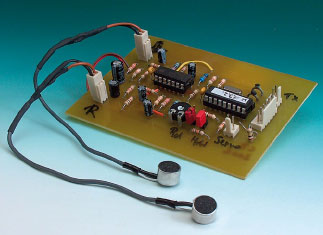Stereo Robot Ears

Service robots of the future will most likely need to act on spoken commands and be able to recognise voices. This article takes a look at one aspect of this behaviour namely locating the position of a sound source using the cross-correlation function. A technique is developed which drastically cuts down on the number crunching so that even a basic microcontroller fitted with binaural sensors can pinpoint a continuous audio signal with an accuracy of just 10 degrees.
This is a MEMBER ONLY article. You need a subscription to read this article.
- Unlimited access to online Member Only articles
- 3 new editions Elektor Magazine (digital)
- More than 5000 Gerber files
- 20% member discount on e-books (at elektor.com)
- 10% member discount on Products (at elektor.com)
Available from €5.33 per month.
What is Members Only
Elektor is committed to providing high-quality content on electronics, catering to tens of thousands of paying members. As part of this commitment, Elektor has launched Premium, an initiative that offers exclusive online articles to members sometimes even before they appear in the magazine.
Every day, members can access in-depth articles that showcase the best of Elektor's premium content.
This initiative aims to reward members with early access. Once logged in, members can easily enjoy this exclusive content and engage in discussions about featured projects. While Premium adds to the existing resources available, Elektor will continue to provide a wealth of free information.
Join the Elektor community today to take advantage of Premium and other benefits!
Materials
Gerber file
CAM/CAD data for the PCB referred to in this article is available as a Gerber file. Elektor GREEN and GOLD members can exclusively download these files for free as part of their membership. Gerber files allow a PCB to be produced on an appropriate device available locally, or through an online PCB manufacturing service.
Elektor recommends the Elektor PCB Service service from its business partner Eurocircuits or AISLER as the best services for its own prototypes and volume production.
The use of our Gerber files is provided under a modified Creative Commons license. Creative Commons offers authors, scientists, educators and other creatives the freedom to handle their copyright in a more free way without losing their ownership.
Component list
Resistors
R1,R5,R12 = 47kΩ
R2 = 33kΩ
R3,R10 = 22kΩ
R4,R11 = 1kΩ
R6,R9,R13,R16,R18,R19,R20 = 10kΩ
R7, R14 = 2kΩ2
R8, R15 = 100kΩ
R17 = 100kΩ preset
Rx = 100kΩ
Capacitors
C1,C2,C3,C4 = 1µF 16 V
C5 = 22µF 16 V
C6 = 100µF 16 V
C7,C8 = 100nF
C9,C10 = 22pF
Semiconductors
IC1 = LM324
IC2 = PIC16F88, programmed, order code 060040-41 from
Miscellaneous
Q1 = 20MHz quartz crystal
DIL14 socket
DIL18 socket
SL1,SL2,(SL4),SL5,SL6,SL7 = 2-way SIL pinheader (SL4 bridged with a 100k resistor, see text)
SL3 = 6-way SIL pinheader
JP1,JP2 = jumper
MicR, MicL = CZ034 electret microphone insert
PCB, ref. 060040-1, free artwork download



Discussion (0 comments)